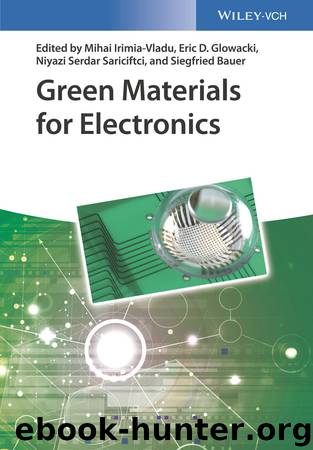Green Materials for Electronics by unknow

Author:unknow
Language: eng
Format: epub
ISBN: 9783527692965
Publisher: John Wiley & Sons, Inc.
Published: 2017-08-30T00:00:00+00:00
5.4 Tunable/Programmable Transience
The properties of the encapsulation layers and/or the substrates for transient electronics provide a means to tune/program the lifespan of a device, with good engineering control. Material options for the encapsulation range from inorganic materials such as MgO, SiO2, and SiNx to degradable polymers, such as PLGA, PCL, silk films, and others, or a combined use of multiple layers of these materials. Figure 5.3a shows measured changes in electrical resistance of a meander trace of Mg, encapsulated with layers of MgO with different thicknesses, and combinations of MgO with crystallized silk films, each due to immersion in DI water at room temperature. Here, as-deposited Mg traces without any encapsulation lose their electrical continuity within an hour. A single layer of MgO with different thicknesses allows adjustment of the lifetime of the device up to 12 h, while a combination of MgO and silk extends the life to over 4 days [1]. Figure 5.3b provides an example of an encapsulation strategy at the device level using metal-oxide-semiconductor field-effect transistors (MOSFETs) with Si NMs for the semiconductor, Mg for the conductor, and MgO/SiO2 for the gate dielectric. When partially submerged in DI water, the device exhibits stable operation for up to 90 h, that is, no degradation in measured transfer curves and drain currents. Rapid transience occurs in a short time interval that follows this period of stable operation. Device characteristics, therefore, exhibit two-step kinetics in function: (i) The encapsulation layers determine the first timescale (stable operation); (ii) the Mg electrodes define the second (rapid transience) owing to a relatively higher rate for dissolution compared to other device materials [1]. Tuning and programming of transience behavior using this type of strategy and more complex variants of it provide important capabilities. Since the solubility of silk fibroin films in water depends on the degree of crystallinity, adjusting this parameter allows the period of device operation to be selected across a wide range, from seconds to years [24, 25].
Download
This site does not store any files on its server. We only index and link to content provided by other sites. Please contact the content providers to delete copyright contents if any and email us, we'll remove relevant links or contents immediately.
Deep Learning with Python by François Chollet(15032)
The Mikado Method by Ola Ellnestam Daniel Brolund(12292)
Hello! Python by Anthony Briggs(12183)
OCA Java SE 8 Programmer I Certification Guide by Mala Gupta(11550)
Dependency Injection in .NET by Mark Seemann(11336)
A Developer's Guide to Building Resilient Cloud Applications with Azure by Hamida Rebai Trabelsi(10530)
Algorithms of the Intelligent Web by Haralambos Marmanis;Dmitry Babenko(10150)
The Well-Grounded Java Developer by Benjamin J. Evans Martijn Verburg(9811)
Grails in Action by Glen Smith Peter Ledbrook(9479)
Secrets of the JavaScript Ninja by John Resig Bear Bibeault(9045)
Hit Refresh by Satya Nadella(9039)
Sass and Compass in Action by Wynn Netherland Nathan Weizenbaum Chris Eppstein Brandon Mathis(9032)
The Kubernetes Operator Framework Book by Michael Dame(8473)
Test-Driven iOS Development with Swift 4 by Dominik Hauser(8437)
Exploring Deepfakes by Bryan Lyon and Matt Tora(8298)
Robo-Advisor with Python by Aki Ranin(8252)
Practical Computer Architecture with Python and ARM by Alan Clements(8225)
Implementing Enterprise Observability for Success by Manisha Agrawal and Karun Krishnannair(8193)
Building Low Latency Applications with C++ by Sourav Ghosh(8099)
